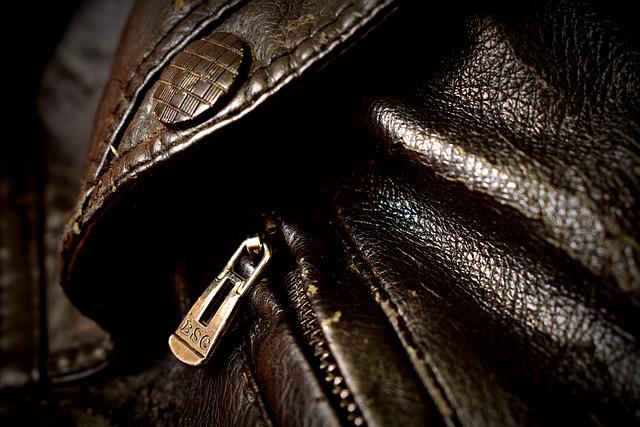Have you heard of synthetic leather? It’s commonly used as a substitute for real leather. Whether you’re shopping for a leather jacket, vest, trousers or any other garment, you can probably find it in synthetic leather. Synthetic leather is designed to look like real leather. While real leather is an organic material, though, synthetic leather is not.
#1) Made of a Coated Base Material
There are different types of synthetic leather, but nearly all of them are made of a coated base material. Base materials include nylon, rayon or polyester. During production, manufacturers will apply a thin layer of polyurethane (PU) or polyvinyl chloride (PVC) over the surface of a base material. PU faux leather features a layer of PU over a base material, whereas PVC faux leather features a PVC layer over a base material.
#2) More Susceptible to Cracking
Both real leather and synthetic leather can crack. With that said, synthetic leather is more susceptible to cracking. This is due to the fact that it features a laminated construction. Synthetic leather is made of layers consisting of a base material and a PU or PVC layer. Over time, the PU or PVC layer may crack. Real leather is less likely to crack because it’s not laminated. Furthermore, you can condition real leather to hydrate and moisture it so that it doesn’t dry out.
#3) Emerged During World War 2
Real leather has been for thousands of years to make jackets and other garments. But synthetic leather didn’t emerge until the 19th century. During World War 2, supplies of real leather ran thin. This led to the invention of an artificial leather known as Presstoff. Presstoff consisted of paper-based pulp with a similar appearance and texture as real leather. Following the advent of Presstoff, other types of synthetic leather were released, including Rexine.
#4) Porous vs Impermeable
Synthetic leather can be porous or impermeable, depending on how it’s made. Real leather, of course, is porous. It has a porous surface that’s characterized by the presence of many small and shallow holes. With its porous surface, real leather can absorb and release moisture particles. Synthetic leather is available with a porous surface or impermeable surface.
Impermeable means the surface is solid and devoid of any holes. When compared to porous synthetic leather, impermeable synthetic leather offers better protection against water damage. There are no holes on the surface of impermeable synthetic leather. Therefore, moisture particles can’t absorb into it. If a jacket is made of impermeable synthetic leather, it will essentially be waterproof. The same can’t be said for jackets made of porous synthetic leather.

#5) No Patina
Unfortunately, synthetic leather doesn’t offer a patina. Patinas are exclusive to real leather. The term “patina” refers to the naturally aged, weather appearance that real leather develops. As real leather ages, it will typically develop a softer, lighter tone.
You won’t get a patina with synthetic leather. Synthetic leather consists of a coated base material. Whether it’s PU or PVC, synthetic leather won’t develop a patina. You need to choose a jacket or garment made of real leather if you’re looking for a patina.
#6) Less Environmentally Friendly
Contrary to common belief, faux leather isn’t an environmentally friendly alternative to real leather. It’s actually less environmentally friendly than its real counterpart. Real leather is an organic material. Like most organic materials, it will decompose. PVC is made of a synthetic material like PU or PVC, which can take a very long time to decompose. And as it sits in landfills, PU and PVC may release harmful chemicals. If you’re an environmentally conscious person, you may want to stick with real leather.
#7) Used for More Than Just Garments
When most people think of synthetic leather, they envision jackets and other garments. Like real leather, synthetic leather is used in many different garments. But don’t let that fool you into thinking that it’s only used to make garments. There are other products that contain synthetic leather Books, for example, often feature synthetic leather for their bindings. Car seats and interiors may feature synthetic leather as well. Many household furniture products like sofas and recliners are also made of synthetic leather.
#8) Inexpensive
The main advantage of choosing artificial leather over real leather is the cost. Artificial leather almost always costs less than real leather. Real leather is made of animal skin, such as cowhide or sheepskin. And it must be tanned and processed, which can take several weeks. Because of its longer and more laborious production process, real leather comes with a higher price tag. You should think of it as an investment, however. Real leather may cost more than artificial leather, but it has unique physical properties that aren’t found in artificial leather.
#9) Smells Different
You may notice that artificial leather smells different than real leather. Real leather has a more natural smell to it. Artificial leather, conversely, has a strong, chemical-like smell to it. Based on their appearance, it’s difficult to distinguish between real leather and artificial leather. But you can often smell the difference between them. If you notice a garment has a chemical-like smell to it, the garment is probably made of artificial leather. This is because artificial leather consists of a synthetic material like PU or PVC, both of which contain chemicals. Real leather doesn’t contain any synthetic material in its construction, so it has a more natural smell to it.
#10) Goes By Many Different Names
Synthetic leather goes by many different names. It’s also called faux leather, for instance. Faux leather and synthetic leather are the same. Both terms are used to describe a synthetic material that’s designed to look and feel like real leather. In addition to faux leather, synthetic leather is also known as initiation leather. And depending on how it’s made, synthetic leather may be labeled as PU or PVC leather. PU is made of PU, whereas PVC is made of PVC.

